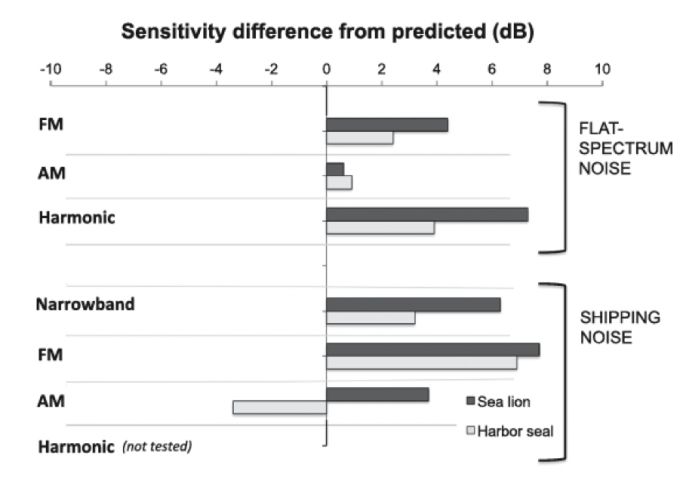On behalf of lead author Kane Cunningham, we would like to provide some information on our recent paper on the detection of complex sounds by seals and sea lions. The goal of this study was to test how auditory data predict detection of complex sounds in quiet and noisy conditions. Our results indicate that pinnipeds may utilize certain common features of natural sounds to enhance detectability (the key figure demonstrating these results is shown above). We believe that this study is relevant given current efforts to predict the effects of anthropogenic noise on marine mammal species. This paper is available online through JASA or a .pdf may be obtained by request from Brandon.Southall@sea-inc.net.

“Auditory sensitivity of seals and sea lions in complex listening scenarios.”
Cunningham, K. A., Southall, B. L., & Reichmuth, C.
The Journal of the Acoustical Society of America, 136(6), 3410-3421 (2014).
Abstract
Standard audiometric data, such as audiograms and critical ratios, are often used to inform marine mammal noise-exposure criteria. However, these measurements are obtained using simple, artificial stimuli—i.e., pure tones and flat-spectrum noise—while natural sounds typically have more complex structure. In this study, detection thresholds for complex signals were measured in (I) quiet and (II) masked conditions for one California sea lion (Zalophus californianus ) and one harbor seal (Phoca vitulina ). In Experiment I, detection thresholds in quiet conditions were obtained for complex signals designed to isolate three common features of natural sounds: Frequency modulation, amplitude modulation, and harmonic structure. In Experiment II, detection thresholds were obtained for the same complex signals embedded in two types of masking noise: Synthetic flat-spectrum noise and recorded shipping noise. To evaluate how accurately standard hearing data predict detection of complex sounds, the results of Experiments I and II were compared to predictions based on subject audiograms and critical ratios combined with a basic hearing model. Both subjects exhibited greater-than-predicted sensitivity to harmonic signals in quiet and masked conditions, as well as to frequency-modulated signals in masked conditions. These differences indicate that the complex features of naturally occurring sounds enhance detectability relative to simple stimuli.
